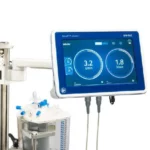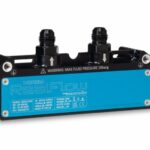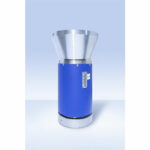Aerospace development is a strategic industry within the British economy. It creates a lot of high value jobs directly and indirectly, while tremendous technological advances spin out of it. But there are other positive aspects to the sector that are all too often overlooked. We look at how one modest supplier has become a small part of the big picture.
The Spitfire, Concorde, the Eurofighter Typhoon. All names to set a young engineer’s pulse racing. But like Lewis Hamilton’s McLaren Mercedes they are figureheads to an industry this is often unglamorous, hard-work, frighteningly competitive and economically challenged.
It is all too easy to lose sight of the fact that Aerospace is an engineering industry just like any other. In reality is it just one piece in the jigsaw that is the national economy – all be it a very important one. Lots of engineers work in the sector their whole career, other take aeronautic developments and rework them for other uses. These are seen as the main technological and economic benefits of the industry.
But there is another, equally important side that is almost always overlooked – mainstream engineers supplying their expertise and insight into the aeronautical sector!
The aerospace boffins constantly learn from the more general engineering sector. For instance there is a long-running drive to improve productivity in design, test and manufacture. Aerospace’s performance in these disciplines has to date been woeful; they designed by government committee and build by hand. But techniques such as simultaneous engineering, design for manufacture, robotics and automation, in common use in many other industries, are now being adapted and adopted.
The use and reuse of equipment and procedures is also becoming the norm, and one small company that has benefited hugely from this is Sensor Technology in Bicester. Commercial Manager Tony Ingham explains: “We make a torque sensor that uniquely is wireless. Instead of a fiddling about to install a complicated mess of slip rings, we just line TorqSense up with the shaft to be tested and use radio waves to capture the live performance data as it is generated”.
“The Aerospace industry is very much one of our markets for TorqSense, so I was pleased when word got out and we now have an ever-growing portfolio of applications on both civil and military projects”.
One of our first transducers was supplied for a simple test rig for British Aerospace. It must have been military, because nobody would confirm or deny anything! But this lead to a rather more open requirements, the reengineering for the Nimrod.
In 2009 the new Nimrod MRA4 will replace the Nimrod MR2 which has provided sterling service to the military since the 1960s. The MR4A is a maritime reconnaissance and attack aircraft that can be configured for multiple roles, including submarine and surface warfare and search and rescue.
TorqSense was instrumental in endurance and integration testing of the aircraft?s mechanical systems. The torque test rig is built around a reclaimed Nimrod MR2 fuselage, complete with operational landing gear, hydraulic system (including engine-driven pumps), primary and secondary flight controls. Flight forces are simulated by a sophisticated electro-mechanical system attached to the moving elements of the aircraft.
Test data are gathered through a variety of sensors, which have to have as little effect on the system under test as possible. TorqSense, being non-contact, causes no drag whatsoever, so there is not even a need to allow for a constant offset when analysing the data.
TorqSense uses two Surface Acoustic Wave (SAW) devices which have embedded tiny ceramic piezoelectric combs. The SAWs are fixed onto the surface of the shaft under test and are excited to resonant and different frequencies. As the torque increases, the combs open and close which changes the resonant frequency each SAW. In effect the combs are frequency dependent strain gauges and the difference in resonant frequency is a measurement of torque. A wireless radio frequency coupling is used to transfer the data signal to a pick-up head.
The same coupling is used to supply power to the SAWs, made possible because the gauges are based on piezo technology so need less than one milliwatt of power. This arrangement does away completely with the difficulties of fitting slip rings and maintaining their contact quality throughout an extended test run.
With this success under its belt, Sensor Technology has picked up several projects including one for the new Falcon 7X business jet. The world’s first fly-by-wire business jet, Falcon 7X carries up to 20 persons over long distances yet can operate from modest airfields.
A test rig was built incorporating 22Nm and 200 Nm TorqSense transducers for the development and qualification testing of three flap system actuators.
Each actuator is tested with a servo hydraulic motor input drive in closed loop control of position against torque which is monitored using the smaller 22Nm TorqSense; the load to the ballscrew lateral motion is applied via a servo cylinder again in closed loop control of position against load.
Proof loading is applied manually to the input drive using a gearbox and the larger 200Nm torque transducer in open loop. Like all aircraft components, the Falcon 7X flap systems were subjected to rigorous and repeating test regimes during their development and similar tests will be rerun throughout their operating life. The use of a non-contact transducer therefore saves considerable time over the lifecycle of the Falcon 7X.
TorqSense was also seen as the only option when SELEX Sensors and Airborne Systems (S&AS) were developing a vertical take-off and landing Unmanned Aerial Vehicle (UAV).
The low-cost, flexible search and surveillance UAV is intended for military, homeland security, policing and environmental monitoring. It is rugged, immediately deployable and can be launched from the ground, ship or even moving vehicles. The vectored-thrust UAV platform is suitable for any situation requiring safe aerial viewing or sensor measurement.
Using a jet engine on the UAV was impractical; a ‘cold fan’ solution was required. This fan is driven, via a drive shaft, by a miniscule but powerful two-stroke engine. Developing this technology required a unique test rig, with an in-line torque sensor so that there were no out of balance forces coming into play.
A thorough review of available sensors showed that only the TorqSense system from Sensor Technology met all their needs. Other requirements included ease of mounting, so that the drive system could be taken on and off the rig frequently, and a need to interface with a PC so that real time performance data could be logged and analysed.
Development time was speeded up because of the ease with which the drive could be lifted on and off the test rig, and the fact that data capture and analysis could be automated. This kept the project on time and within budget; a slip in either could have lead to cancellation.
In fact TorqSense may be adapted it to become a permanent feature of the UAV. This would allow the operators to monitor the drive conditions in flight.
Tony sums up: “I am pleased that we are able to supply TorqSense to the Aerospace industry, but you could have knocked me down with a feather when I was told it the technology was being considered for use actually in flight!”







